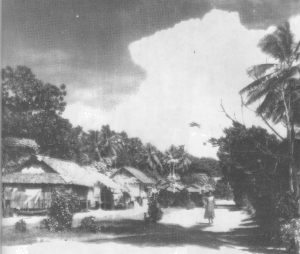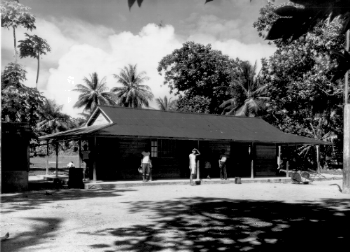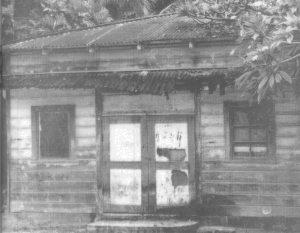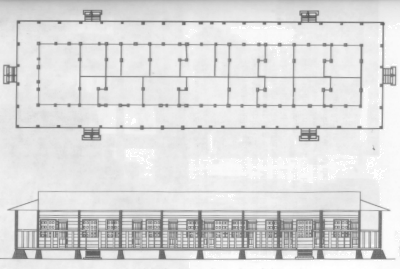Essays on the Marshallese Past
Japanese Colonial & Military Architecture
in Micronesia

|
After the Japanese had taken over the German possessions in Micronesia, in 1914, they took over the administration of Micronesia, first as part of the naval Government, later as part of the civilian government. The award of the islands to Japan as a Class "C" mandate of the League of Nations meant that the Japanese Government needed to develop a permanent headquarters. Koror, on Palau was chosen. The headquarters complex, although much more elaborate than any other administrative building in Micronesia before or after, precipitated what was to become the standard set of features of Japanese Colonial Architecture: buildings erected on concrete pillars; buildings which were very long in relation their breadth, low-slung roofs falling off to all sides; very wide verandahs all around the building; large-sized windows and large doors taking up most of the wall space.
The style of buildings remained the same ever after, because these features made practical sense in Micronesia. Buildings were erected on concrete posts or L-shaped supports to get them off them ground, thereby both providing cooling from underneath and distance to the wetness of the soil which would speed up deterioration of the woods. The roof were low-slung and had slopes falling off to all sides as such shapes would experience little wind load during the high-speed winds brought about by typhoon systems. Further, the buildings were single-story with their eaves well below the tree-line, such protected from the danger of having the roof blown off by winds caught under the eaves. There, where the tree cover had to be removed, or where the walls would provide large wind resistance, the architects resorted to the use of guy wires and ground anchors.
The buildings were erected with large frames and a densely set series of trusses. This type of construction became the Japanese Colonial Standard and was taught to Micronesians by instructors in both theory and practical work. This is of little surprise if one realizes that the architect of the South Seas Government (Nan'y– Cho) Buildings in Palau, Mr. Mochizuki, was asked by the Governor of the Nan'y– to set up a "South Seas Woodworking Institute" (Mokko Totei Yosejijo) in Palau to teach Micronesians the Japanese way of carpentry.
Concrete structures were also built for civilian uses in the 1930s, but mainly in the more urban centres, such as Koror and Saipan. Examples are the Post Office Building in Saipan or the metereological station on Jabwor, Jaluit. The first concrete structures in Micronesia, however, date to the German times, such as German bell tower at Colonia, Pohnpei, or the German Agricultural and Forestry Research Station at the same location.
It is unclear to date to what extent such civilian buildings were built in preparation for later use by the armed forces, or whether the armed forced merely took over a successful and proven design. It is beyond doubt, however, that the then existing buildings were put to use by the armed forces. Given the observations on Wotje, Taroa and Jaluit, were concrete "civilian" administration buildings were uniformly altered to become the command centres and radio-communication centres of these bases, a long-term and well thought out plan appears to be more likely, whereby apparently civilian buildings were built during the pre-war period with the intention to use them in a future military conflict.
The wooden buildings on the Japanese bases in Micronesia are generally erected on concrete foundations. As far as has been seen on the Marshall Islands, three different

The main road on Majuro Island in 1946. The traditional Marshallese architecture prevails. (Photo U.S. National Archives).

The old Japanese administration building on Majuro Atoll, photographed in 1946

The trade store of the Nan-y– B–eki Kaisha on Majuro Island ("Laura") photographed in 1990. The building collapsed in 1992.
The wooden buildings on the Japanese bases in Micronesia are generally erected on concrete foundations. As far as has been seen on the Marshall Islands, three different foundations have been used: (i) concrete floors and basal walls with cast-in iron bolts for the installation of the wooden sleepers, (ii) L-shaped concrete blocks situated at the corners, and (iii) buildings erected on small concrete pillars. In all instances the intention was to elevate the wooden parts of the buildings above the ground level to reduce rot.

Plan and elevation of a Japanese Barracks in the Marshall Islands


Bibliographic citation for this document
Spennemann, Dirk H.R. (1998). Essays on the Marshallese Past Second edition.
Albury:
URL: http://marshall.csu.edu.au/Marshalls/html/essays/es-ww2-9.html

CONTACT:
Dirk H.R. Spennemann,
Institute of Land, Water and Society,
Charles Sturt University, P.O.Box 789,
Albury NSW 2640, Australia.
e-mail: dspennemann@csu.edu.au

| select from the following... |
|
|
|
|
|
|
|
|
|
|
|
|
|
|
|
| |
|
|





